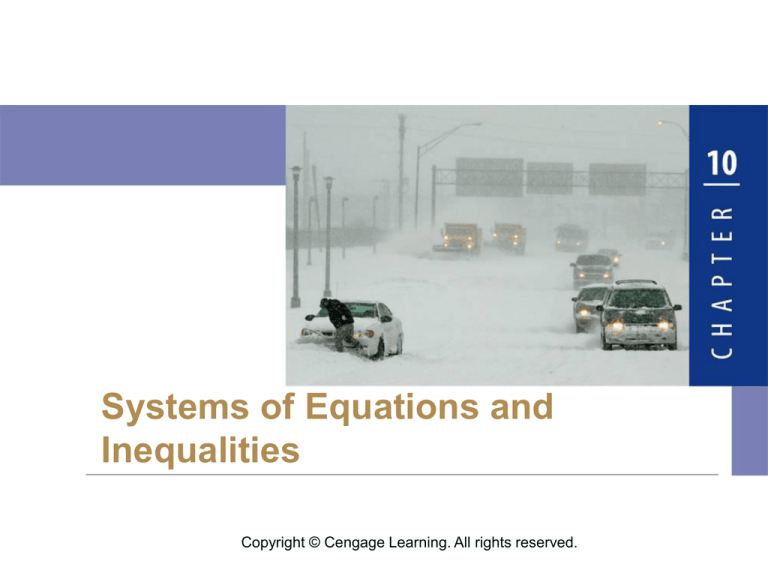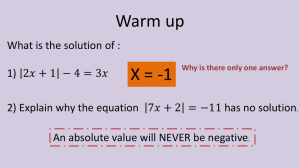
Systems of Equations and
Inequalities
Copyright © Cengage Learning. All rights reserved.
10.8
Systems of Nonlinear
Equations
Copyright © Cengage Learning. All rights reserved.
Objectives
► Substitution and Elimination Methods
► Graphical Method
3
Systems of Nonlinear Equations
In this section we solve systems of equations in which the
equations are not all linear.
4
Substitution and Elimination
Methods
5
Substitution and Elimination Methods
To solve a system of nonlinear equations, we can use the
substitution or elimination method, as illustrated in the next
examples.
6
Example 1 – Substitution Method
Find all solutions of the system.
x2 + y2 = 100
3x – y = 10
Equation 1
Equation 2
Solution:
Solve for one variable: We start by solving for y in the
second equation:
y = 3x – 10
Solve for y in Equation 2
7
Example 1 – Solution
cont’d
Substitute: Next we substitute for y in the first equation
and solve for x:
x2 + (3x – 10)2 = 100
x2 + (9x2 – 60x + 100) = 100
x=0
Substitute y = 3x – 10 into Equation 1
Expand
10x2 – 60x = 0
Simplify
10x(x – 6) = 0
Factor
or
x=6
Solve for x
8
Example 1 – Solution
cont’d
Back-substitute: Now we back-substitute these values of
x into the equation y = 3x – 10:
For x = 0: y = 3(0) – 10 = –10
Back-substitute
For x = 6: y = 3(6) – 10 = 8
Back-substitute
So we have two solutions: (0, –10) and (6, 8).
9
Example 1 – Solution
cont’d
The graph of the first equation is a circle, and the graph of
the second equation is a line; Figure 1 shows that the
graphs intersect at the two points (0, –10) and (6, 8).
Figure 1
10
Example 1 – Solution
cont’d
Check Your Answers:
x = 0, y = 10
(0)2 + (–10)2 = 100
3(0) – (–10) = 10
x = 6, y = 8
(6)2 + (8)2 = 36 + 64 = 100
3(6) – (8) = 18 – 8 = 10
11
Example 2 – Elimination Method
Find all solutions of the system.
3x2 + 2y = 26
Equation 1
Equation 2
5x2 + 7y = 3
Solution:
We choose to eliminate the x-term, so we multiply the first
equation by 5 and the second equation by –3. Then we add
the two equations and solve for y.
15x2 + 10y = 130
–15x2 – 21y = –9
–11y = 121
y = –11
5 Equation 1
(–3) Equation 2
Add
Solve for y
12
Example 2 – Solution
cont’d
Now we back-substitute y = –11 into one of the original
equations, say 3x2 + 2y = 26, and solve for x.
3x2 + 2(–11) = 26
3x2 = 48
x2 = 16
x = –4 or x = 4
Back-substitute y = –11 into Equation 1
Add 22
Divide by 3
Solve for x
So we have two solutions: (–4, –11) and (4, –11).
13
Example 2 – Solution
cont’d
The graphs of both equations are parabolas. Figure 2
shows that the graphs intersect at the two points (–4, –11)
and (4, –11).
Figure 2
14
Example 2 – Solution
cont’d
Check Your Answers:
x = –4, y = –11:
3(–4)2 + 2(–11) = 26
5(–4)2 + 7(–11) = 3
x = 4, y = –11:
3(4)2 + 2(–11) = 26
5(4)2 + 7(–11) = 3
15
Graphical Method
16
Graphical Method
The graphical method is particularly useful in solving
systems of nonlinear equations.
17
Example 3 – Graphical Method
Find all solutions of the system.
x2 – y = 2
2x – y = –1
Solution:
Graph each equation: Solving for y in terms of x, we get
the equivalent system
y = x2 – 2
y = 2x + 1
18
Example 3 – Solution
cont’d
Find intersection points: Figure 3 shows that the graphs
of these equations intersect at two points. Zooming in, we
see that the solutions are
(–1, –1)
and
(3, 7)
Figure 3
19
Example 3 – Solution
cont’d
Check Your Answers:
x = –1, y = –1:
(–1)2 – (–1) = 2
2(–1)2 – (–1) = –1
x = 3, y = 7:
32 – 7 = 2
2(3) – 7 = –1
20
Example 4 – Solving a System of Equations Graphically
Find all solutions of the system, correct to one decimal
place.
x2 + y2 = 2
Equation 1
Equation 2
y = 2x2 – 5x
Solution:
The graph of the first equation is a circle, and the graph of
the second is a parabola.
To graph the circle on a graphing calculator, we must first
solve for y in terms of x.
21
Example 4 – Solution
cont’d
x2 + y2 = 12
y2 = 12 – x2
Isolate y2 on LHS
Take square roots
To graph the circle, we must graph both functions.
and
22
Example 4 – Solution
cont’d
In Figure 4 the graph of the circle is shown in red, and the
parabola is shown in blue. The graphs intersect in
Quadrants I and II. Zooming in, or using the Intersect
command, we see that the intersection points are
(–0.559, 3.419) and (2.847, 1.974).
(a)
x2 + y2 = 12, y = 2x2 – 5x
Figure 4
(b)
23
Example 4 – Solution
cont’d
There also appears to be an intersection point in Quadrant
IV. However, when we zoom in, we see that the curves
come close to each other but don’t intersect (see Figure 5).
Thus the system has two solutions; rounded to the nearest
tenth, they are
(–0.6, 3.4) and (2.8, 2.0)
Zooming in
Figure 5
24




